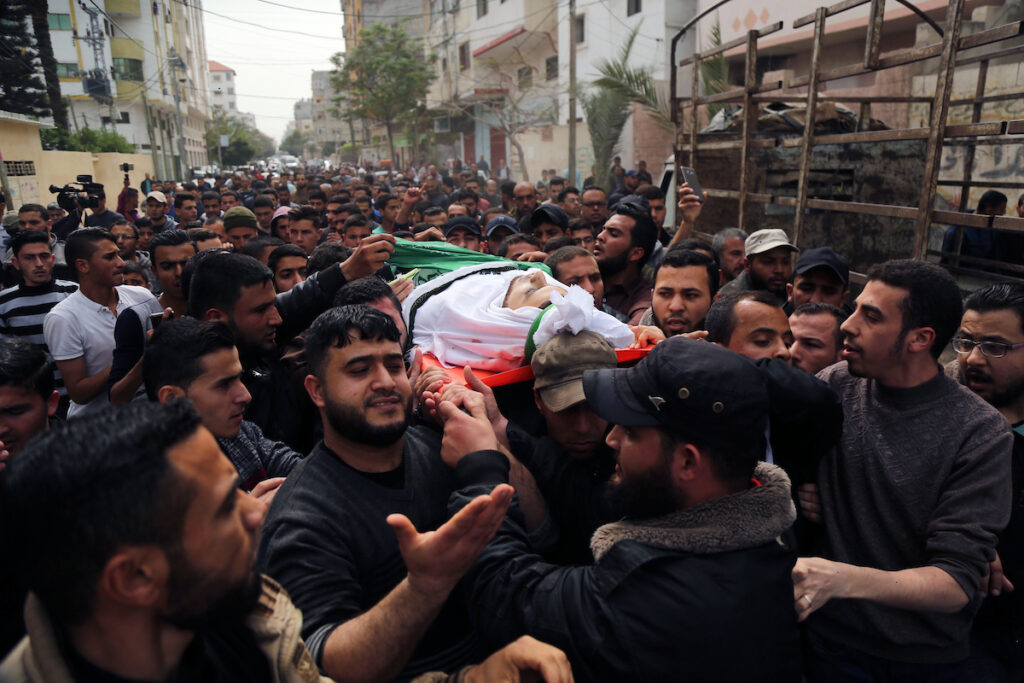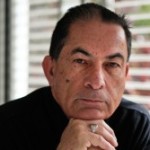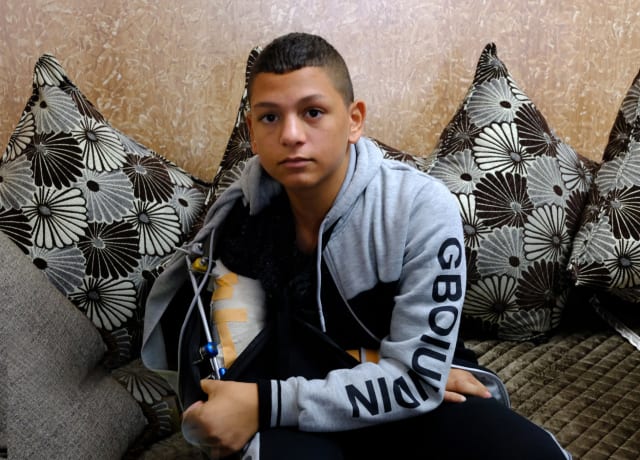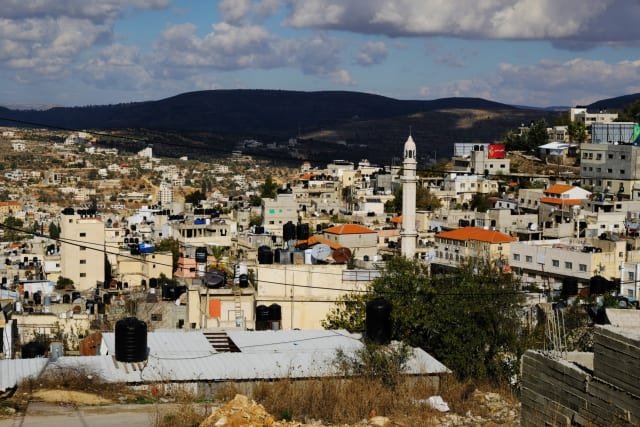These Boys Would Have Made It Home after School, if It Weren’t for Israeli Sniper Fire
PALESTINE - ISRAEL, 9 Dec 2019
6 Dec 2019 – Two children, aged 11 and 13, from a refugee camp near Ramallah, were hiding from army forces during a stone-throwing incident. When they stood up they were wounded – shot from a distance by an IDF sniper.
Anyone who sees Amir Zubeideh would find it hard to believe that there are soldiers who are capable of aiming their rifles at such a small child – he looks younger than his 11 years – and shooting him with live ammunition. Anyone who hears his chirpy voice and sees his sweet face, won’t believe it. It’s also hard to understand how Israel Defense Forces soldiers shot his friend, Rami Abu Nasara, who’s a little older, already 13, bar-mitzvah age. The two children were targeted from a distance, first Rami and then Amir, by a sniper who took aim and fired, while they hid, frightened, behind a concrete wall and then tried to run for their lives.
The school attended by the children of the Jalazun refugee camp is situated on the road to nearby Ramallah, at the entrance to the camp. Before descending to their cramped houses, to the piles of garbage, the crowding and abject poverty that characterize this camp, one of the most squalid in the West Bank, they sometimes vent their frustration by throwing stones at the IDF watchtower at the back entrance to the Beit El settlement, opposite their school, which was established by the United Nations Relief and Works Agency for Palestine Refugees.
This is the “National Service” of these children, who have little else to do in their spare time amid the wasteland they call home. This is their protest against the settlement that has spread in every direction across the way and totally upends their lives – the lives of children under military occupation. Only a row of olive trees separates the school from the first houses in the huge settlement that is choking Jalazun and preventing it from growing, leaving it gasping for air in a narrow valley below the highway.
Sometimes the soldiers come down from their tower and provoke the children with shouts and tear gas, sometimes it’s the children who start throwing stones, and sometimes the soldiers lie in ambush for them amid the olive trees. In every case, however, these are primary-school children throwing stones from a distance at a fortified watchtower. That was the case, too, on Sunday, November 17. In the early afternoon, hundreds of children poured out of the school following seven hours of classes. Most of them went west, heading home. A few dozen turned eastward, for the daily stone-throwing ritual.
The area around the school is strewn with even more garbage than was the case when we visited after another youngster from the camp, Mahmoud Nakhle, was killed here almost exactly a year ago in the very same spot. At that time, soldiers shot the teenager in the back as he fled, wounding him, and then moved him around for 15 minutes and prevented an ambulance from evacuating him, until he succumbed to his injuries.
Since then, more garbage has piled up at this killing field and educational site – a boys’ school on one side of the road, closer to the settlement, a girls’ school on the other side, closer to the refugee camp. This time, too, soldiers used live ammunition on children who were running for their lives, but this time, fortunately, they only wounded them.

Palestinians carry the body of Mujahid al-Khudari 23, who was killed by Israeli security forces during clashes along Israel border with Gaza.
Photo by Dawoud Abo Alkas
The children moved toward the tower and the settlement, on this particular Sunday; not all of them were throwing stones. Five to seven soldiers came down from the tower and fired tear-gas grenades and stun grenades at them to push them back, toward the camp. The soldiers advanced, the children retreated. After a half-hour, another force of a few soldiers joined the operation. One was apparently wearing civilian clothing – according to eyewitness testimony collected by Iyad Hadad, a field researcher for the Israeli human rights organization B’Tselem – and was carrying a sniper’s rifle. At about 2 P.M., live fire commenced, most of it, apparently, from his rifle. He stood on the eastern side of the road, amid the garbage, and fired at the western side, at the fleeing children.
Related: Palestinian shot dead when Israeli troops mistake his towel for a firebomb
Two clothes peddlers from the Balata refugee camp, who come here in their commercial vehicles to sell their wares twice a week, parking on the roadside, found themselves in the line of fire. Terrified, they crouched down inside their vehicles, caught between the fleeing children and the soldiers. One of them, Islam Ibrahim, 25, told Hadad that two bullets slammed into their windows and endangered their lives.
During our visit this week, we cross the road with Hadad to the place where the children hid – between the wall that surrounds the home of Yasser Kundar, the most remote house in the camp, and another, shorter wall in front of it. A few bricks mark the spot where Nakhle was killed a year ago; his photograph hangs in a store a few meters from the hiding place. The distance between that place and the spot where the sniper was standing – in the shade of the olive trees, on the other side of the highway – is about 120-150 meters, as the crow flies.
The Zubeideh family lives in a small, cramped house in the heart of the camp. The father of the family, Ihab, is sprawled on a sofa in the center of the tiny living room, packets of medication on the table next to him. He’s been lying here for the past seven years, after his lower body was paralyzed in the wake of failed back surgery; he never leaves home. He has a walker, but says that every step he takes is for him “like moving a boulder,” and every movement causes him excruciating pain. Even when his child lay wounded in a hospital, he wasn’t capable of going to tend to him. Ihab, who was an English teacher under the auspices of the Palestinian Authority, speaks the language fluently. He’s 47, his wife, Samiya, is 40, and they have five children, of whom Amir is the youngest.
Amir is sitting on a sofa next to that of his disabled father. His right arm is in a cast for its entire length; he’s wearing a green and black Fila track suit. A sixth-grade pupil, he’s well-groomed and all smiles.
“It was a regular day,” says Amir in his child’s voice about the day he was shot. His father urges him on: “Tell the truth, the whole truth.” Amir says that he wasn’t throwing stones at the soldiers and was simply caught in the shooting. His father adds, “And if he was throwing stones? Would he have hurt Israel? Is a small boy like him capable of hurting Israel? He’s 11 years old.”
Amir says he fled to the other side of the road and hid next to the small wall. He shows us how he crouched down. Another few children were also there, hiding by the wall. At one point, he recalls, he felt that he had to get away and he stood up. That’s when a rubber-coated metal bullet struck him in the stomach. He stretched out his right hand to protect his chest and stomach, and was then hit by a second bullet, apparently a live round. The movement of his hand may have saved his life.
A piece of shrapnel entered his chest and the physicians decided to leave it there for the time being. A small scar shows the place where the fragment penetrated. The palm of his right hand, with which he tried to shield himself, was hit and two fingers were shattered. “How does it happen?” his father asks. “How does it happen that soldiers shoot a small boy like this?”
Amir started to run. He didn’t yet grasp that he’d been shot, even though he felt pain and saw blood. Friends bundled him into the car of Dia Baraka, another resident of the camp, who rushed him to the Istishari Arab Hospital, a private institution adjacent to Ramallah.
His mother, who got to the hospital fast, thought her son was hovering between life and death. “So many tubes were connected to his little body, and his pupils rolled up,” she relates. She screamed hysterically.
Ihab lay at home, immobile, waiting for news. Amir says he thought he was going to die, because of the tubes, the blood and the melee around him.
“I wasn’t afraid,” Amir says in his thin voice.
He was discharged after four days in the hospital.
Why do you think your son was shot, we ask Ihab Zubeideh.
“You are from Israel. You know that they don’t need any reason to shoot.”
When Amir was placed in the car and taken to the hospital, Rami Abu Nasara, the other boy, who had been shot before him by the sniper and was more severely wounded, was already there. His home, which overlooks the camp, is more spacious and elegant. Rami’s father, Razhi, is the camp’s baker. He now serves his homemade pastries to his guests.
Rami’s whole arm is bandaged and connected by screws to an iron splint. Razhi, 40, and Nasara, 33, have five children. Rami, a seventh-grader, is the eldest. He says he knew Amir from school, but in the hospital they became friends. Rami’s mother hands him a glass of milk.
He, too, talks about the tear gas and the stun grenades fired by the soldiers and about the escape; he climbed over the wall of the house he was hiding behind. He warned the other children who were with him – all of them younger, four or five from the fifth and sixth grades – not to dare stand up, because it was dangerous. When the shooting died down momentarily, he himself stood up – which is when he was immediately hit by a bone-shattering bullet in his right arm. He managed to run away and was hustled by friends into a car that evacuated him. He was semi-conscious, but remembers Amir crying next to him. They received no first aid until they reached the hospital. Rami underwent surgery and needs a second operation.
The IDF Spokesperson’s Unit this week stated, in response to a query from Haaretz: “On November 17, there was a disturbance near the town of Jalazun, which is under the jurisdiction of the Binyamin Regional Brigade, during which dozens of Palestinians threw stones at troops and endangered them. In order to disperse the stone-throwing and remove the danger, the forces used crowd-dispersal methods including the firing of rubber bullets and shooting into the air. In the report received by IDF officials, it was claimed that two youths were wounded by rubber bullets.”
“Shooting small children has become normal in the eyes of the soldiers,” says Razhi, Rami’s father. “It’s so easy for them to shoot a little boy.”
In the meantime, the two children aren’t going to school. Their parents are afraid that something will happen to them. Someone might push them during recess.
_____________________________________________
 Gideon Levy is a Haaretz columnist and a member of the newspaper’s editorial board. Levy joined Haaretz in 1982, and spent four years as the newspaper’s deputy editor. He was the recipient of the Euro-Med Journalist Prize for 2008; the Leipzig Freedom Prize in 2001; the Israeli Journalists’ Union Prize in 1997; and The Association of Human Rights in Israel Award for 1996. His new book, The Punishment of Gaza, has just been published by Verso.
Gideon Levy is a Haaretz columnist and a member of the newspaper’s editorial board. Levy joined Haaretz in 1982, and spent four years as the newspaper’s deputy editor. He was the recipient of the Euro-Med Journalist Prize for 2008; the Leipzig Freedom Prize in 2001; the Israeli Journalists’ Union Prize in 1997; and The Association of Human Rights in Israel Award for 1996. His new book, The Punishment of Gaza, has just been published by Verso.
Tags: Apartheid Wall, Conflict, Fatah, Gaza, Geopolitics, Hamas, Human Rights, Israel, Nakba, Oslo Accords, Palestine, Palestine/Israel, Politics, Power, Settlers, Social justice, State Terrorism, UN, USA, Violence, West Bank, Zionism
Join the BDS-BOYCOTT, DIVESTMENT, SANCTIONS campaign to protest the Israeli barbaric siege of Gaza, illegal occupation of the Palestine nation’s territory, the apartheid wall, its inhuman and degrading treatment of the Palestinian people, and the more than 7,000 Palestinian men, women, elderly and children arbitrarily locked up in Israeli prisons.
DON’T BUY PRODUCTS WHOSE BARCODE STARTS WITH 729, which indicates that it is produced in Israel. DO YOUR PART! MAKE A DIFFERENCE!
7 2 9: BOYCOTT FOR JUSTICE!
DISCLAIMER: The statements, views and opinions expressed in pieces republished here are solely those of the authors and do not necessarily represent those of TMS. In accordance with title 17 U.S.C. section 107, this material is distributed without profit to those who have expressed a prior interest in receiving the included information for research and educational purposes. TMS has no affiliation whatsoever with the originator of this article nor is TMS endorsed or sponsored by the originator. “GO TO ORIGINAL” links are provided as a convenience to our readers and allow for verification of authenticity. However, as originating pages are often updated by their originating host sites, the versions posted may not match the versions our readers view when clicking the “GO TO ORIGINAL” links. This site contains copyrighted material the use of which has not always been specifically authorized by the copyright owner. We are making such material available in our efforts to advance understanding of environmental, political, human rights, economic, democracy, scientific, and social justice issues, etc. We believe this constitutes a ‘fair use’ of any such copyrighted material as provided for in section 107 of the US Copyright Law. In accordance with Title 17 U.S.C. Section 107, the material on this site is distributed without profit to those who have expressed a prior interest in receiving the included information for research and educational purposes. For more information go to: http://www.law.cornell.edu/uscode/17/107.shtml. If you wish to use copyrighted material from this site for purposes of your own that go beyond ‘fair use’, you must obtain permission from the copyright owner.
Read more
Click here to go to the current weekly digest or pick another article:
PALESTINE - ISRAEL:

